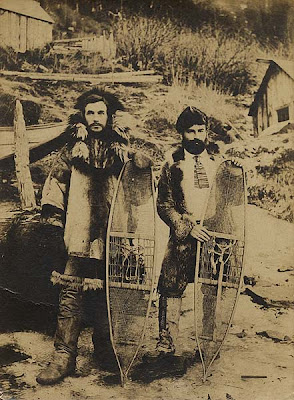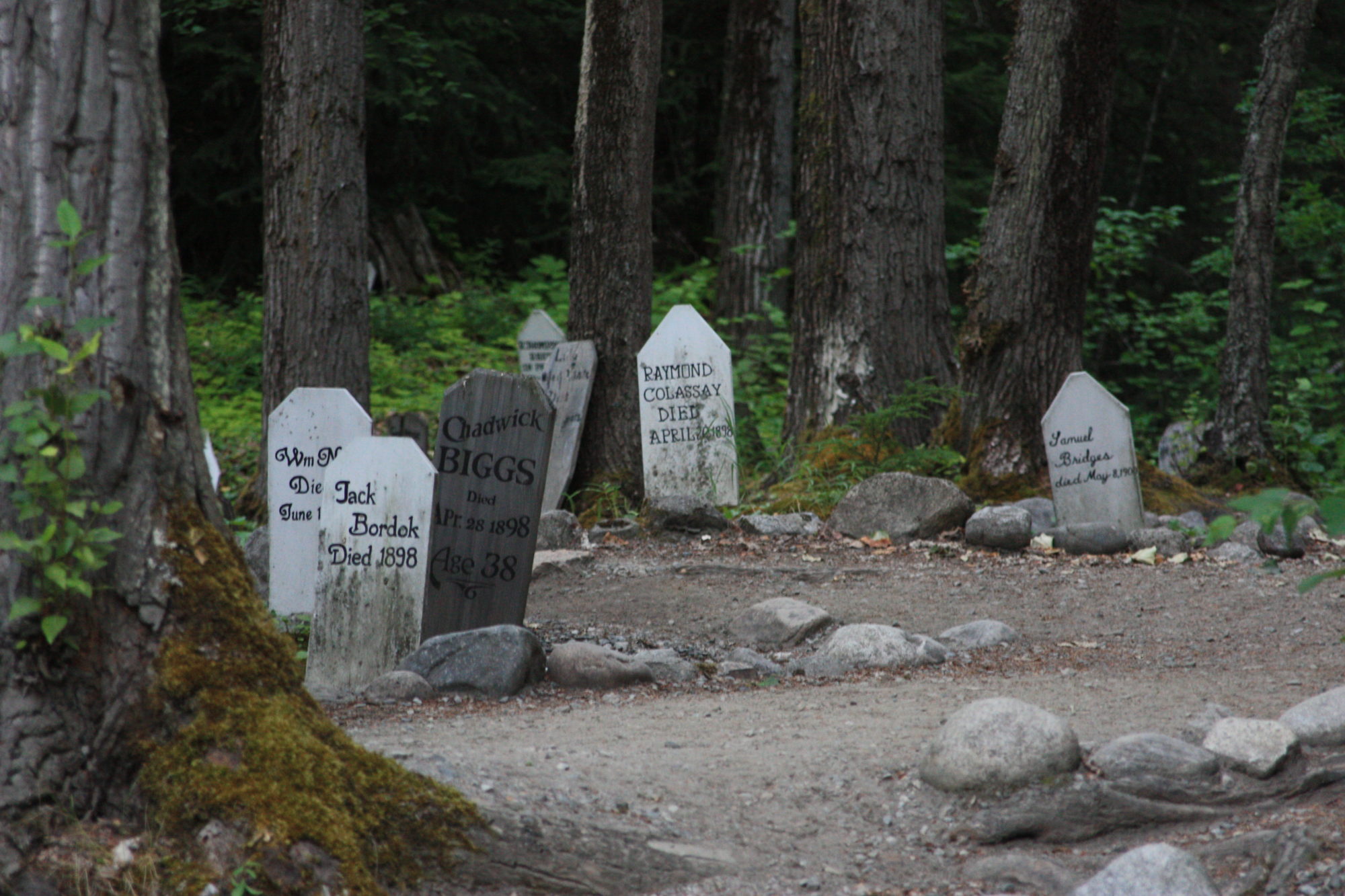 Last weekend we went to Atlin, it was beautiful. Stayed at the Brewer’s Bay Chalet which, although clean and plain has a million dollar view of the lake and snow covered mountains. After walking around town in the rain, we visited the Atlin Cemetery and photographed this curious monument to Harper Reed, gentleman adventurer. Have not been able to find out anything more, if anyone knows, please leave a comment.
Last weekend we went to Atlin, it was beautiful. Stayed at the Brewer’s Bay Chalet which, although clean and plain has a million dollar view of the lake and snow covered mountains. After walking around town in the rain, we visited the Atlin Cemetery and photographed this curious monument to Harper Reed, gentleman adventurer. Have not been able to find out anything more, if anyone knows, please leave a comment.
Porcupine Camp
White Pass City saloons
Skagway had many saloons but it did not have the record of number of saloons per capita.
The most saloons per buildings was claimed by White Pass City, where it was said there were 17 saloons in a town that had only 16 buildings (one was “at large”). White Pass City was a community of sorts that was half way up the Trail of ’98, (the railroad path to the summit from Skagway). Although now owned by the National Park Service, access is extremely difficult and must be done from the road. In the past 15 years it has been done only rarely and those being rangers sent there several years ago. They descended a steep cliff of about 2000 feet, crossed a treacherous raging river – bushwacking the entire way. They just don’t make rangers like those anymore……(Seth, Liz, Jim)!
from Alaska Hootch, the history of alcohol in early Alaska, by Thayne I. Anderson, online quoting Scott Dial “The Gold Rush Saloon”.
The Telegraph Line
I have often wondered about the telegraph lines seen along the road in various places with the glass insulators. In 1898-99 when the narrow-gauge White Pass & Yukon Route Railway was built, from Skagway through the White Pass to Bennett City near the BC-Yukon border, they also put in the telegraph line. Before construction was completed in July 1899, the Canadian Privy Council approved the extension of the telegraph line to Dawson City and a spur line to Atlin, British Columbia, where a gold strike had occurred the previous year. Construction on the 1,000-kilometre Yukon portion of the Yukon Telegraph line began at Bennett Lake and finished in Dawson City in September 1899 ahead of schedule. Twenty-eight men, four of whom drowned in the Yukon River, completed the work in six months, traveling by waterway and stringing wire at a rate of 10 to 16 kilometres a day. The estimated cost for the project was $135,750. Supplies arrived in Skagway from as far away as Great Britain, including 600 miles of No. 8 (5mm) wire, hundreds of boxes of insulators and side blocks, and provisions for a 100-man workforce. John Franklin Richardson, construction superintendent worked for John Baptiste Charleson the supervisor of construction. J.C. Tache was the chief engineer (seen above in Skagway) and Joseph Gobeil was the private secretary. Even Michael J. Heney helped by supplying pack horses to bring the supplies to the pass. There are lots more really intereting stories about this in the following book: Wires in the Wilderness: The Story of the Yukon Telegraph by Bill Miller
Winter fly over!
So each day in the summer Paul Swanstrom flies his little red plane from Skagway and Haines over Glacier Bay. Just think what the miners would have thought if they could have flown over instead of crawled over the passes!
Here is a really neat video he posted of a winter trip!
1911 MURDER

Although I do not have the specifics on the murder in 1911, what we do know is that two native Tlingit men were arrested and sent to San Quentin. Thomas Jacob Phillips born on this day, March 21, 1890 in Killisnoo Alaska and “Skookum Joe” Wright born 1867 in Dyea were accused of the murder. According to a report in 1994 done for the Department of Interior and the Department of Agriculture by the Institute of Economic Research, University of Alaska Anchorage, Gorsuch, Colt, Smythe and Garber authors, the two Native men were falsely accused and imprisoned.
On page 13 of this paper, according to Salvation Army records, Joe Wright was “converted” around the turn of the century while he was working as a packer on the pass. After the trial, he was sent to San Quentin and there, he was recruited by the Salvation Army. He was released in 1912, returned to Haines and started the Salvation Army Church there. He started the Salvation Army band then and he continued to proselytize in Haines and Klukwan until his death. Tom Phillips, the other man accused of murder and sent to San Quentin went on to serve in World War 1. He died in 1941 in Sitka and is buried in the Sitka National Cemetery there.
Seen above is the Salvation Army band of Klukwan, although I do not have a date, my guess is that Joe Wright is pictured in it.
rootsweb; paper online: http://www.iser.uaa.alaska.edu/Publications/5southeast_cmnts/AppendixA.pdf
Thornton, 2004 page 93
Whitehorse?
Alexander Pantages

Alexander was born in 1867 in Andros, Greece. He ran away from home at the age of nine while with his father on a business trip in Cairo, Egypt. He then went to sea and spent the next two years working on merchant ships all over the world. Although he left Greece at a tender age he never forgot his home country and seems to have been conscious of his ethnic identity. Thus, he changed his name to Alexander after hearing about Alexander the Great.
He came to Skagway in 1897 and worked for Ma Pullen as a waiter. He later used Klondike Kate for money and ran the Orpheum in Dawson. In 1902, Pantages left Dawson and moved to Seattle, Washington, where he opened the Crystal Theater, a short-form vaudeville and motion picture house of his own. By 1920, he owned more than 30 vaudeville theatres and controlled, through management contracts, perhaps 60 more. In 1929 he was accused of raping a 17-year old woman. Pantages was tried, convicted and sentenced to 50 years in prison, despite his claim that he was “set up by Joseph Kennedy.” (Kennedy had offered to buy his theaters in 1927 but Pantages refused.) He was later acquitted in the appeal trial, after his lawyers portrayed the victim as a woman of low morals.
Pantages died on February 17, 1936 and was interred in the Great Mausoleum, at Forest Lawn Memorial Park in Glendale, California.
Wikipedia; Highjinks, page 156
Joseph Victor Begin
NWMP Inspector Begin was in Dyea in 1897. He was born on this day, February 15, 1856 in Quebec and spent several years working on steamboats on the St. Lawrence River and then served in the militia for three years before joining the NWMP in 1885. He served in several provinces before coming to the Yukon. In 1891 he married to Alexina Chartrand and in 1893 had a daughter, Renalde, and then two sons: Francoise Begin born in 1894, and Jean Berchmans Begin, born in 1897. His family must have lived in a larger community, not Dyea, certainly, judging from photos of the family.
From here he went to South Africa and later served in the Great War – a euphemism for WW1 which was big but not all that great. In 1929 he moved to Atlanta Georgia where he died.
The photos of Captain Begin were small and grainy but the fellow on the horse in this poster looks like he posed for this.
various Canadian history sites online.
Bill Gates and the eggs

“Swiftwater Bill” Gates, or Charles H. Gates was born in 1855 in Minerva New York. He was working as a boatman in Idaho in 1896 when he decided to go to Alaska. He and some partners leased “Thirteen El Dorado” which later paid out and made him a millionaire. Enjoying his new wealth, he would walk the streets of Dawson in top hat, white shirt and jacket (and said to bathe in champagne). He apparently loved women and gambling. He had the hots for Miss Gussie Lamore in Dawson and offered her her weight in gold to marry him. She however spurned him, and was seen in the restaurant with a new boyfriend ordering fried eggs – the most expensive item on the menu. So, to get even, Bill bought up all the eggs in Dawson and fed them to dogs, in another version fed them to the other dance hall girls. Miss Gussie loved eggs and so he hoped to get her attention. Apparently it worked as she offered to meet him in San Francisco and marry him (despite already being married). He married her younger sister, Grace, then divorced her and remarried and divorced several times in the next few years.
Swiftwater Bill was known to be at the gold fields of Nome, Alaska at the same time as William H. Gates I, grandfather of the Microsoft founder. However, despite the similarity in name and coincidences of geography, there is no apparent family relationship between “Swiftwater Bill” and Microsoft founder Bill Gates.
In any event, some versions say that in 1933 he went to Peru and was mining silver there, when on this date, February 13, 1933 he died in mysterious circumstances, perhaps murder…..another account says he was murdered on February 21, 1937 and still another that he died of pneumonia following surgery back in Neillsville, Clark County, Wisconsin on February 13, 1933.
In any event, he certainly lived an exciting life.
Seen above with Joe Boyle-left, “Swiftwater Bill” on the right.
Source: Neillsville Press (Neillsville, Clark County, Wis.) 16 Feb. 1933 obituary of “Swiftwater Bill” Gates.
http://wvls.lib.wi.us/ClarkCounty/clark/data/1/bbs16/16906.htm



